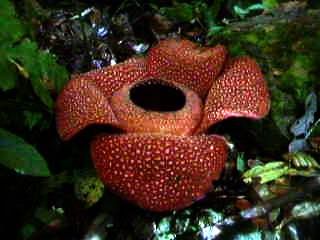Rafflesia- The Worlds Largest Flower

History
There is even more to tell of its ‘discovery’ and its claim to fame as the largest flower on earth. In the year 1818, Sir Stamford Raffles was posted as Governor to Bencoolen in Sumatra which was then, the administrative centre for the British East India Company for Western Sumatra. Raffles’s interest in natural sciences was insatiable.
A respected and popular member of the Royal Society in London, Raffles arranged and persuaded a fellow society member - Dr.Joseph Arnold to accompany him on an expedition into the interiors of Sumatra. It was on one of these expeditions that they stumbled on a discovery which was to puzzle botanists for a long time. Unfortunately, Dr Arnold died because of jungle fever before presenting the report to the society.
Habitat
Rafflesia are endemic to Southeast Asia recorded 17 known species, the Rafflesia flowers have been found only in Indonesia - Sumatra and Java, Malaysia, including Borneo island and south Thailand. Rafflesias have small, brownish, scale like leaves and fleshy, foul-smelling flowers of various sizes from few inches to meter big in diameter. Rafflesia classified as parasite, which means it just takes the nutrient out of its host.
The Rafflesia can be found at altitudes of between 500 and 700 meters in the forests of Malaysia, Southern Thailand, Sumatra and Java in Indonesia. In these tropical rainforests, the climate is continuously warm and humid, with very high humidity. The Rafflesia is rare and fairly hard to locate. It is especially difficult to see in bloom; the buds take up to 10 months to develop and the blossom lasts for just a few days. However, how many these strange plants are survived in primary rainforest is still unknown.

Characteristic
The cabbages like bugs that produce before blooming are size of cabbage. The large fleshy flower is what we usually notice; this is the flower’s sexual organ. There is a deep well in the centre of the flower containing a central raised disc that supports many vertical spines. The sexual organs are located beneath the rim of the disk, and male and female flowers are separate.

The reddish brown colors of the petals, sprinkled with white freckles exudes act most unpleasant stench, similar to rotting flesh or carrion. Some people believe that the stench attracts flies and insects which help disperse the seeds. Others believe that large animals could be agents for this seed dispersal. In order for the seed to germinate, it was found that the vine of the host plant must be damaged in some way so that the filaments of the seed may infiltrate successfully. The damage to the host vines could be made by trampling hoofs of large animals. The seeds adhere to the passing animals’ hoofs and are transported to other places where they can find host plants to attach to.
http://www.endemicguides.com/Rafflesia.htm








































